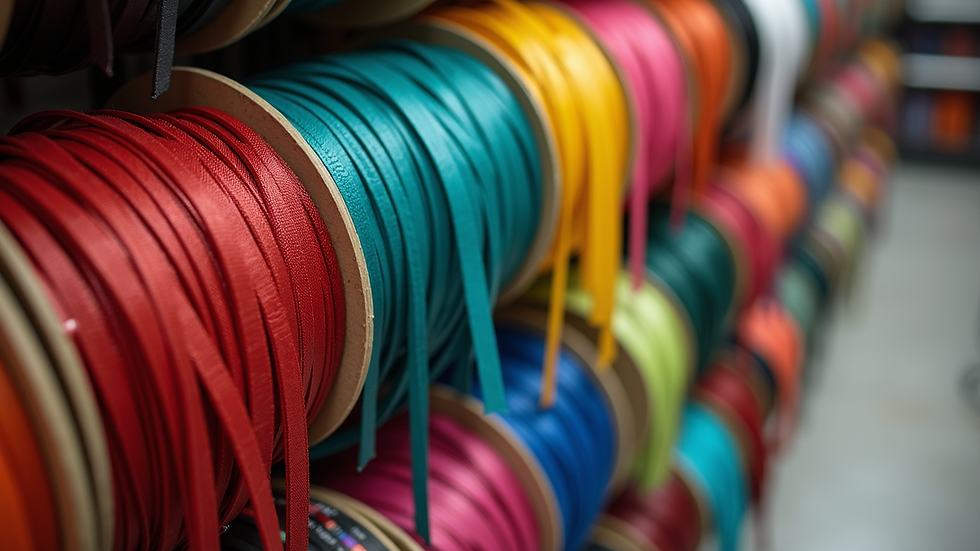Exploring Creativity in Industrial Webbing Patterns
- Saksham Tiwari
- Jun 11
- 3 min read
Industrial webbing plays a vital role in various applications, from securing loads in transportation to providing functional support in various industries. As we delve deeper into the creative possibilities of industrial webbing patterns, we see that they are not just practical components; they also reflect artistry and innovation. In this blog post, we will explore the unique aspects of industrial webbing, discuss the creative patterns that can be created, and highlight the importance of creativity in this field.
Understanding Industrial Webbing
Industrial webbing refers to straps, belts, and other forms of flexible material designed for strength and durability. Commonly made from materials like nylon, polyester, and polypropylene, industrial webbing is utilized in a variety of industries including outdoor equipment, automotive, and military applications.
Consider, for instance, how webbing is employed in securing cargo during transport. It is crucial for ensuring safety on highways and at shipping docks. Moreover, as businesses recognize the importance of aesthetics and branding in their products, the demand for creatively designed webbing has surged.

The Art of Webbing Patterns
When we think of webbing, we often picture plain, utilitarian designs. However, creativity can transform a simple strap into an artistic statement. Manufacturers are increasingly incorporating vibrant colors, geometric shapes, and even custom logos into their webbing designs.
For example, companies like Radhika Printtex are known for their ability to produce unique print designs that cater to various tastes. Their offerings allow businesses to integrate brand identity into their products through customized webbing patterns. This not only enhances the aesthetic appeal but also builds brand recognition.

Practical Applications of Creative Webbing
The integration of creativity into industrial webbing is not limited to aesthetics. In many instances, innovative webbing designs enhance functionality. Webbing with reflective patterns, for example, can increase visibility in low-light conditions, making it ideal for safety gear and outdoor equipment.
Additionally, the use of braided or textured patterns can provide better grip during use. This feature is vital in fields like climbing or rescue operations, where a secure hold is imperative. Companies that focus on these creative adaptations not only cater to aesthetic preferences but also address safety and performance needs.
Benefits of Innovative Webbing
Investing in innovative webbing offers several advantages. First and foremost, unique designs can differentiate products in a crowded market. Manufacturers who embrace creativity position themselves as leaders in style and functionality.
Moreover, creative webbing can lead to enhanced customer satisfaction. Products that combine aesthetic appeal with practical benefits usually resonate more with consumers. This connection often translates to customer loyalty and repeat business.
Lastly, embracing creativity in industrial webbing can foster a culture of innovation within a company. Employees may feel motivated to think outside the box, leading to groundbreaking techniques and materials that can redefine the industry.

The Future of Industrial Webbing Creativity
As we look to the future of industrial webbing, we can expect advancements driven by technology and innovation. The rise of wearable technology and smart textiles introduces new dimensions to webbing applications. Flexible, miniaturized sensors can be integrated into the webbing itself, turning it into a smart product.
Moreover, sustainability is becoming a crucial factor in manufacturing processes. Future trends may include eco-friendly materials that do not compromise on durability or design. Companies that lead in this direction will not only meet market demand but also contribute positively to the environment.
In conclusion, exploring creativity in industrial webbing patterns reveals an exciting intersection of functionality and art. As we embrace the various applications and benefits of innovative webbing, we set the stage for a future rich with possibilities. Through design, creativity, and technological advances, the realm of industrial webbing is set to grow and inspire.
Ultimately, it is this blend of creativity and practicality that will define the future of industrial webbing, ensuring it remains relevant and essential across numerous industries.




Comments